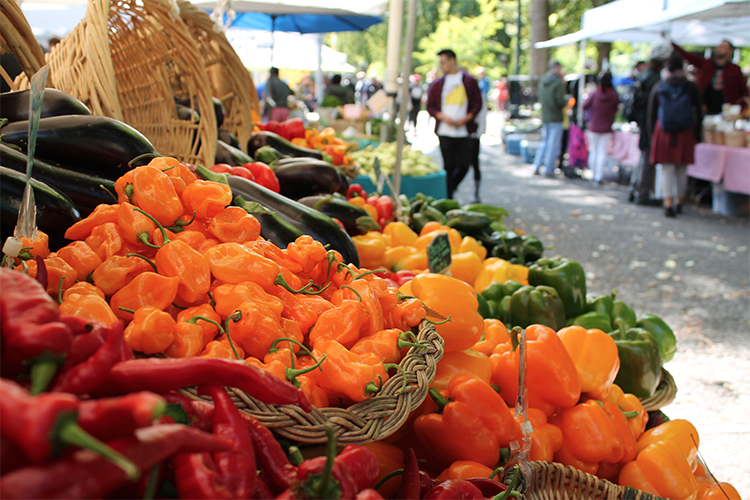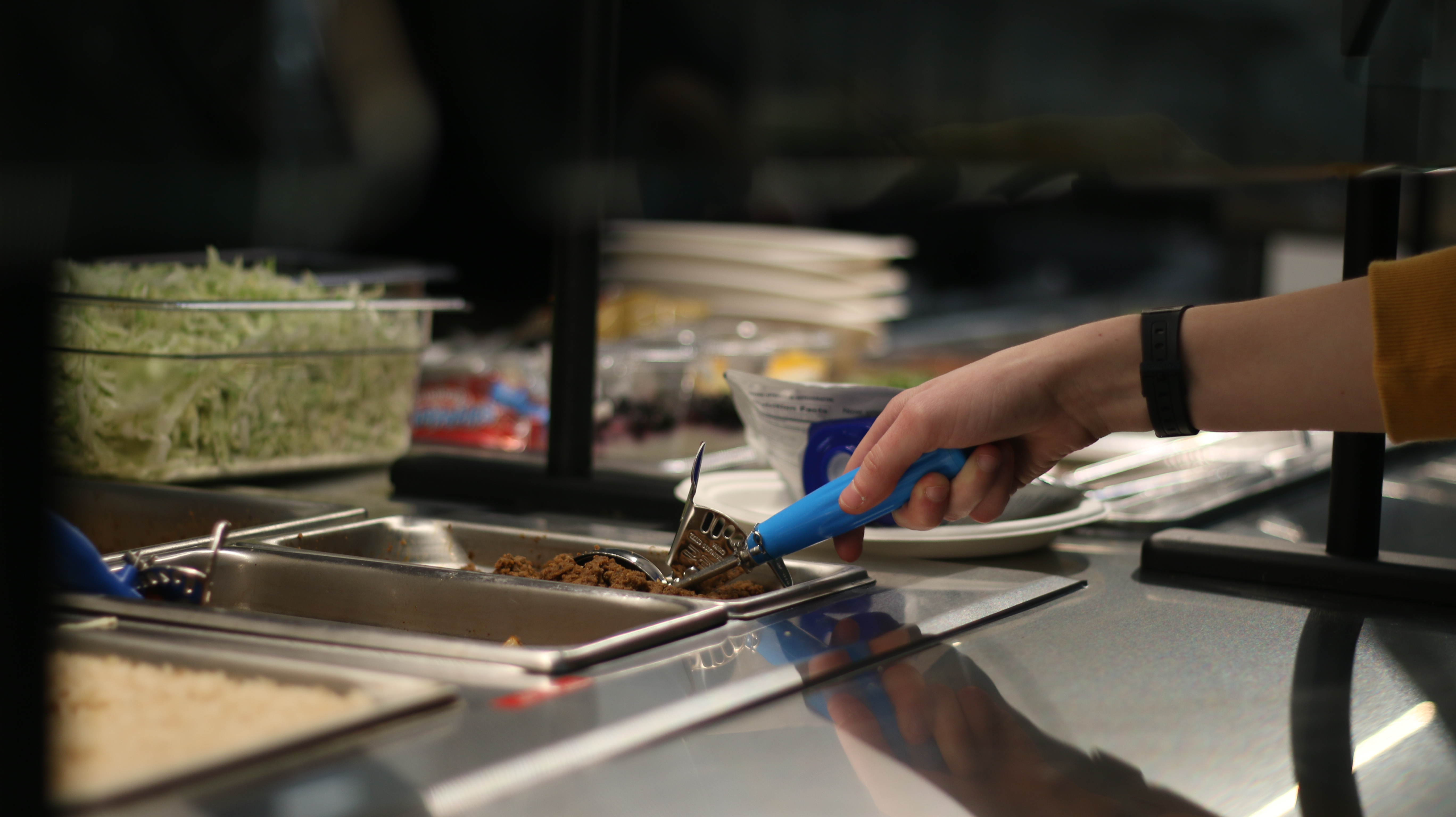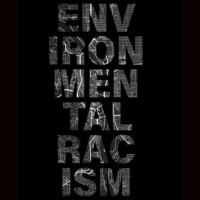
Avocado flattens beneath Ciela Barrow’s fork as she prepares her first meal of the day. After sprinkling hemp seeds atop her toast as a final touch, the Grant sophomore harvests kale leaves from her family’s garden to add to her smoothie for extra nutrients. She switches on the blender and goes to the cupboard to pick out a date bar for her lunch while the deep green leaves begin to mix with pale yellow pineapple chunks.
Blocks away, ground beef sizzles as it hits the pan. Sam Sheridan prods and pushes it around until the red meat turns to a light brown. After his meat is done cooking, Sheridan heads outside to the chicken coop. He unlatches the door and the chickens begin to rustle around in the hay.
As a rower, the Grant senior prioritizes a protein-heavy breakfast, usually consisting of one-third of a pound of beef and three eggs.
According to a study by the University of Oxford, the agriculture industry accounts for one-fourth of global greenhouse gas emissions. Livestock farming dispenses high levels of methane, which readily absorbs the heat of the sun and contributes to the warming of the atmosphere.
To decrease their individual climate footprint, some people have turned to voluntary diet choices These diets entail little to no consumption of animals or animal products.
“(Climate change is) one of the biggest issues that the world is facing right now and I’m just trying to do the most for that … they cut down a lot of trees for beef farming and for dairy farms … so obviously, cutting meat and dairy out of my life, I think, has a huge impact on that,” says Ciela Barrow, a vegan.
From deforestation and harmful pesticides to waste and contribution to global warming, the agriculture system impacts the environment. “When food goes into (the) landfill, it produces methane and methane is a very, very potent greenhouse gas and much more than say, CO2,” says Pam Barrow, the Vice President of Energy, Environmental and Sustainability for Food Northwest. Food Northwest is a trade association which encompasses food processors throughout Oregon, Washington and Idaho.
Although an easy decision for some, voluntary diet choices are not accessible nor practical for everybody. Sustainably grown and organic foods are often sold at higher prices than their mass-produced counterparts. Lifestyle, medical conditions and personal beliefs also play a significant role in decisions about food consumption.
Gerard Martinez, a Portland resident and climate activist who has been vegan for six years, encourages people to make a change in their diets. “I like to think of it in an esoteric way,” he says. “You know, we have to think on many different levels. Every way we can fight against climate change, whatever way we can fight against injustice, we should be doing it. We should be trying to stop our oppressive behaviors once we become aware of them.”
Although veganism can lower individual carbon footprints, many staples of vegan and vegetarian diets can also have a negative impact on the environment. The transportation of out-of-season fruits and vegetables, for example, can result in increased greenhouse gas emissions due to fuel combustion in trucks and other vehicles.
As veganism becomes a more popular lifestyle choice, the demand for meatless food continues to grow.
This demand has led to an increased amount of growth, production and shipping of crops. In many cases, crops need to be flown to the United States in bulk. This process requires large amounts of fuel, contributing to pollution and resource consumption.
Aside from the type of food that is being consumed, transportation and source location also determine sustainability. According to The Independent, eating lamb chops from a local farm is much better for the environment than eating an avocado exported from across the world. “I think that if we shifted a lot more of our resources to sustainably grown meat it could be a lot more affordable and accessible to people,” says Sheridan.
“The amount of resources that it takes: fuel, water, all the things that it takes to get something from point A to point B, exponentially is bigger and bigger and bigger and using up more and more resources the further away it is,” says 2D Stropparo, a farmer’s market vendor for Squirrel and Crow Soy-Free Tempeh.
Portland, Ore. has an abundance of farmer’s markets throughout the year, where food is often locally and ethically sourced, limiting transportation emissions.
In many cases, veganism is interpreted as a shaming tactic. “I’ve had people come to the schools and stuff talking about vegan diets and like how we should switch,” says Sheridan. “I think it’s…one-sided and people should see the bigger picture.”
“After the climate strike … I was walking around and a man came up to me with these pamphlets … about veganism and how you know, horrible the meat industry is and he was like ‘you should take this’ like ‘hey, you’re saving the planet, you’re saving the animals, you should take this’ and so he was pushing it a lot on me,” says senior Rhylie Woodley, who says she has seen the shaming of meat consumption occur, both at Grant and in the larger Portland community.
“It’s going mainstream where people are kind of demonizing meat,” says Sheridan.
Similarly, Stropparo structures her diet based on availability and quality rather than societal pressure. She says that if locally sourced animal products are offered to her, she prioritizes supporting the farmer over vegetarianism. “I’ve gotten away from being dogmatic about having to be one way or another,” she says. “I’ll go weeks without eating any meat or any dairy products but I’m not so strict that I alienate myself when I’m in the company of other people that are serving me food.”
Regardless of its complications, eating sustainably or removing meat from one’s diet is not an option for everyone.
“Implementing these new (sustainable) technologies does cost a lot of money and so there could be a change in the cost of a product,” says Pam Barrow. “I think that’s an issue that we need to deal with … are we providing … reasonably priced food choices with nutritional value to all people? It’s been identified as a social justice issue and that’s something that we need to take a look at.”
At the organic grocery store Natural Grocers, some vegetarian options are significantly more expensive than meat. Ground beef costs $7.75 per ounce, while the Beyond Burger, a meatless alternative, costs $11.78.
Neomie, who has asked that her last name remain confidential, is a family advocate for Family Support and Connections through LifeWorks NW, an organization that supports families in the areas of mental health, addiction and stability. Neomie says that there are many situations which could lead to a family’s
inability to purchase sustainable food, or to purchase food at all.
“Situations can happen and cause an entire person’s monthly budget to be spent on securing safety for the family, and then they have used all their funds and only have so much to get through the month with their assistance from the state to pay for the food,” she says.
A common form of federal assistance for families struggling to obtain food is the Supplemental Nutrition Assistance Program (SNAP). SNAP benefits are allocated in the form of a card which can be used at a multitude of shops or markets to purchase food. However, the amount of aid given can make it hard to put this money toward sustainable eating.
Neomie estimates that a family of three would receive approximately $10 a day to spend on food. Purchasing organic bread at a store such as Natural Grocers costs $5.25, over half of this daily budget. In comparison, the cost of a 24-ounce loaf of multigrain bread at Walmart is $1.88.
“I think about how, you know, if you have only access to 7-Eleven, you’re going to be buying more processed foods that have very little to no nutritional value. And you have a bunch of garbage because it’s such a small package and it’s wrapped,” says Neomie.
At Grant High School, social worker Catrina Knoerzer runs the Four Star Food Project, which collects and distributes food for low-income families in the Grant community. Packed by Knoerzer and donated by volunteers, the project fills backpacks with food to send home to families over the weekend or holiday breaks.
The Four Star Food Project asks for “non-perishable food,” often packaged foods containing pesticides and preservatives.
“They’re not fresh so I think that’s key … when you’re putting stuff in boxes and cans, they last longer, right? There are preservatives in them so therefore, they aren’t as healthy,” says Knoerzer. “Their priority is making sure that their family has food regardless of what it is. They’re not looking at the health side of it, they’re looking to get day by day and providing this (food) to their families.”
Veganism and vegetarianism can be beneficial to the environment, but the necessity of food will continue to make it difficult to balance economic limitations with climate-conscious foods. Neomie says, “There are so many angles of sustainability that goes into our diets … But as far as I can tell, when you are on a government assistance program and you’re shopping, you’re not usually picking out exactly what you want, and what is the best choice for you.”

Zoe McKenna
Deck Family Farm
She/Her
“Deck Family Farm is a biodynamic farm, so basically they are using a diversity of animals that they
rotate through the pastures and crops … Everything is working together, and it’s a very intricate system, and to be able to walk into that and actually be in a flow, it’s such a gratifying feeling … It’s just a real thing, it’s not a concept anymore, it’s like a real practice, it’s a lifestyle … Instead of spreading nitrogen fertilizer over everything, actual systems are happening, so we’re sequestering carbon from the atmosphere, putting it back in the soil which gives for a more nutritious grass, so when the cows eat the grass you’re getting more nutritious value in your meat … I think a lot of people just don’t realize that there is another option. So … (not eating meat is) more of a fear-based choice, like trying to find control rather than like, releasing into it and being like ‘oh OK, I’m a part of something greater. It’s not that I’m a problem and am destroying the planet.’ There’s a way we can be integrated in our practices and make those choices so everyone can do what they want, no judgment.”

Larry Christensen
Climate activist
He/Him
“If you had to kill an animal yourself to eat it, I think people wouldn’t do that … The animals are so sweet, the ones that we’re killing. Even chickens. Have you ever hung around with chickens? They’re really neat. And pigs, pigs are very smart. (Eating meat is) bad for your body, your health, it’s bad for the environment, it wastes a lot of money and also … the gas that gets passed out from animals is a lot of methane and that’s one of the worst greenhouse gasses. There’s a lot of reasons why not to eat (animal products), even if it’s cheese, you know, you’re not killing the animal, you still have to raise the animal and there’s still the greenhouse gasses and it takes a lot of pasture to raise an animal … I’m a Buddhist monk … (We are) really trying not to hurt anybody or anything and we also practice meditation which allows you to see that you’re really interdependent with all things. We couldn’t survive a minute without the earth and the air and water and plants and everything … So just starting to see that we aren’t really separate, we’re connected with all things, and so, in a way, to abuse anything is abusing our own hearts. So hurting others or hurting animals is hurting ourselves. Have respect for all life because we depend on all life.”

Anonymous Siblings at David Douglas High School
S: He/Him
Junior
R: She/Her
Freshman
What do you usually eat at home?
S: At home usually … noodles and hot dogs.
R: (For me it’s) sandwiches. I’ll normally make sandwiches, like peanut butter and jelly.
S: (It doesn’t) really (change from day to day) unless my mom cooks. (We get a home cooked meal) every weekend almost … It’s way better than ramen.
R: Ramen is like, ‘Ok, it’s there, I could eat it if I really haven’t eaten or I’m by myself and I can’t make anything else.’
S: Ramen just gets boring after a while and it’s good to change it up.
Where does your family shop for groceries and how much do you usually spend?
S: (Our food comes from) Walmart, Safeway.
R: (The typical cost of groceries is) probably $200 … every month and if, like something runs out, we’ll wait until like multiple things runs out and then we’ll go … (Our food sources are accessible) sometimes. Sometimes. Because our grandma can’t drive and then if my mom drives, it’s only if she’s like, feeling good. If she doesn’t feel good, then nobody gets to go anywhere but (my brother), because he knows how to use the bus and I don’t.
What is the lunch like at school?
S: (On free and reduced lunch) you can get, (a) peanut butter and jelly sandwich, sometimes a burger with fries. You can get a salad or like a little smoothie thing … It’s only good because I’m really hungry.
R: (School food is) not healthy at all, I mean, the salad, the salad (has) got chicken in it, so I mean that’s half-healthy … I mean, they have two different salads, one with meat and one without, and they also have like a piece of bread in it and string cheese that you could honestly just throw out. Eating that every day, I think I would go crazy.
How often do you eat fast food?
S: We only get fast food unless it’s like, absolutely necessary, like no one’s willing to cook … Or unless there’s like no food in the house at the time.
S: (It is) expensive, so expensive.
R: I would probably spend like $5. My mom? She spends like $2 … we’ll go on budget if we know we’re going somewhere that (will) cost a lot. We’ll make sure we go like $6 or under.
How often do you think about the cost of food?
R: I think about it all the time … It’s harder because you can’t get certain things.
S: All time, every time we go … it’s sort of teaching us how to watch your spending and watch what we buy.




